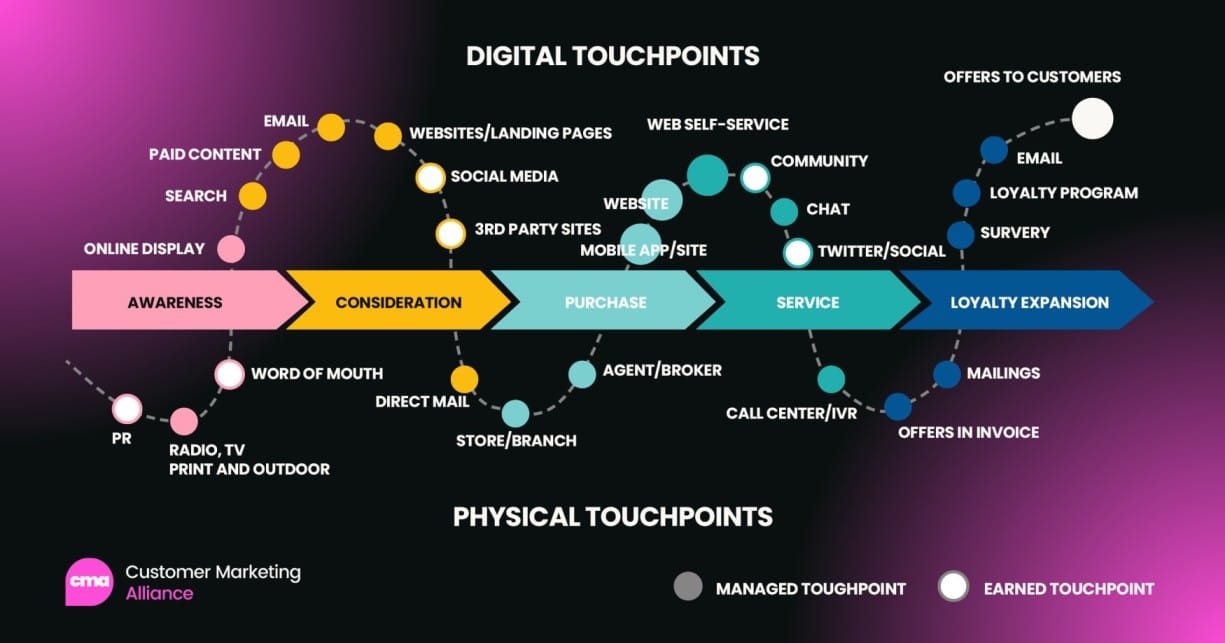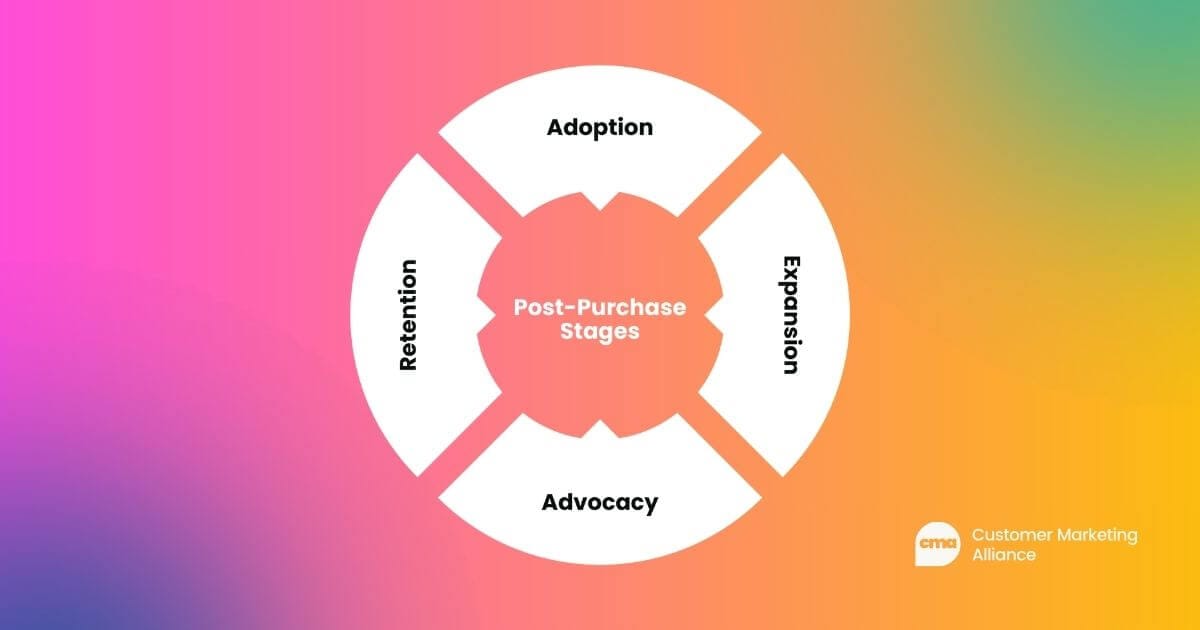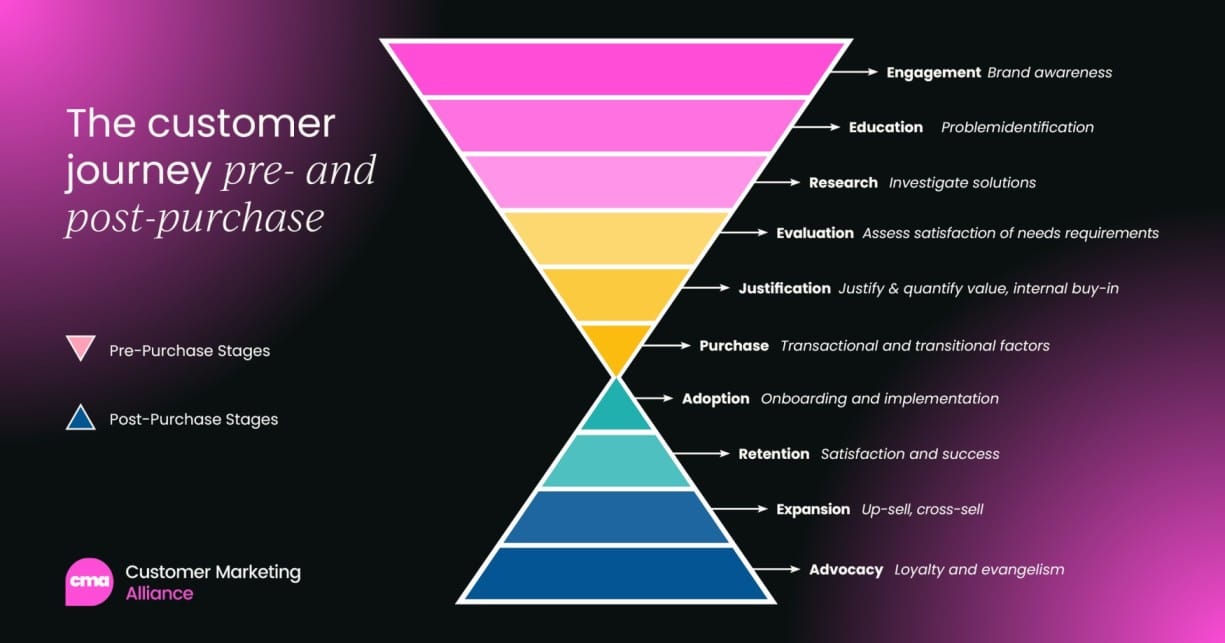The relationship between a customer and a brand is much like a story, with its own beginning, middle, and ongoing chapters. Each interaction, whether digital or physical, adds to this narrative and shapes how customers perceive and engage with your organization. That's why it's vital to map your customer journey and make each interaction count.
In this guide, we'll explore how to map, understand, and optimize this journey to create lasting customer relationships.
- An overview of what the customer journey looks like,
- Its relevance to customer marketing,
- How to approach customer journey mapping, and
- The possible challenges it can present.
What is the customer journey?
At its core, the customer journey represents every interaction a person has with your brand over time.
However, the path a customer takes with your brand isn't just a straight line originating from the awareness stage, through to the point of purchase, and culminating in advocacy. If only it were so simple!
Instead, it's a non-linear, complex web of interactions across various touchpoints and channels, emotions, and decisions that shape their entire experience.
Think of it as a detailed map showing not just where customers go, but how they feel and what they think along the way. This journey isn't limited to just purchases – it encompasses everything from the first time someone hears about your product to their ongoing relationship with your brand years later.
The customer journey aims to understand the point of view of the customer and how they experience an organization across the various touchpoints.
As Georgia Watson, Sales Enablement at IBM points out:
"Even in the buying stage, customers increasingly value positive experiences over anything else, with 85% for B2B and 79% for B2C customers."
Traditionally, most journeys are represented in linear form, from A to B. However, the reality is that there are often cycles or cases of skipping across the course of the customer journey.
Why the customer journey matters in customer marketing
Mapping out this journey allows organizations to better understand any pain points, particularly how the consumer arrived at these points, and reveals opportunities for intervention.
When organizations take the time to map customer journeys, they gain a powerful tool for understanding and improving customer experiences. This process reveals:
Understanding and mapping the customer journey is critical for customer marketing because:
- It helps reduce churn: By identifying pain points, you can proactively fix issues and improve retention.
- It increases customer lifetime value: A smoother experience keeps customers engaged longer and more likely to buy more.
- It creates a seamless onboarding experience: Customers who get value quickly are more likely to stick around.
- It improves personalization: Knowing customer needs at different stages allows you to tailor content, support, and offers.
- It boosts advocacy: Happy customers share their experiences, bringing in more referrals.
Each customer will approach this journey differently. This is why customer personas are at the heart of how customer journeys work; they should be mapped specifically to a particular persona, as customer behavior and touchpoints will vary.
Journey mapping isn't just an exercise in documentation – it's a strategic tool that drives real business outcomes. Organizations that excel at customer journey management typically see higher customer satisfaction, increased retention rates, and stronger revenue growth.

Generally speaking, the starting point is the moment that a potential customer becomes aware of the product or service.
- How customers actually interact with your brand, rather than how you think they do
- Where friction points exist that might be driving customers away
- Opportunities to create memorable positive experiences
- Ways to align internal teams around customer needs
The pre-purchase customer journey in the marketing funnel
Like the foundation of a house, the customer journey cannot be stable and produce the end result (advocacy) if it's not properly constructed.
Before we get to the point of purchase, this initial phase is where potential customers begin forming their perceptions of your brand, testing whether your solutions align with their needs, and evaluating if your organization truly understands their challenges. It's typically broken down into two parts: the awareness and consideration stages.
The awareness stage
Every customer relationship starts somewhere. In the awareness stage, potential customers are just beginning to realize they have a need or problem to solve. They might not even know solutions like yours exist yet. This is where your brand's presence in the right places becomes crucial.
Consider how people might first encounter your brand:
- Through a carefully crafted search engine result
- Via a thought-provoking social media post
- From a colleague's casual recommendation
- Through targeted advertising
Marketing teams will typically produce content to attract your target market and your target customer. These efforts will attract prospective customers by promising a customer journey that will create a customized experience for themselves.
But the key to success in this stage isn't just being visible – it's being helpful. Your content and messaging should focus on understanding and addressing customer problems rather than immediately pushing your solution.
The consideration stage
Once prospects know about your solution, they enter a more detailed evaluation phase. This is where the real investigation begins, as they weigh up the prospective brand against alternative solutions before seeking out reviews, case studies or product demos in the decision-making phase.
There are a range of channels and touchpoints, and depending on the nature of the purchase involved, these could be physical, digital, or a combination of these. Prospects will conduct their own market research, looking at a variety of options before settling on your product.
During consideration, potential customers:
- Research multiple solutions in depth
- Compare features and pricing across competitors
- Read reviews and case studies Seek out product demonstrations
- Evaluate implementation requirements
What makes this stage particularly complex is that different types of customers approach it differently. A technical user might dive deep into specifications and integration details, while a business user might focus more on ROI calculations and ease of deployment.
Your role during this stage is to provide clear, honest information that helps prospects make informed decisions. This means offering detailed product documentation, transparent pricing information, easy access to demonstrations or trials, clear comparisons with alternative solutions, and readily available customer success stories.
The post-purchase journey in the marketing funnel
A helpful way of looking the latter half of the customer journey is considering it as the beginning of a partnership rather than the end of a sale. This crucial period determines whether a customer becomes a lifelong advocate or a one-time buyer.

The purchase stage
The moment a customer decides to buy represents a critical transition – it's where the excitement about possibilities meets the reality of implementation. Making this transition smooth requires careful attention to:
- Clear, simple purchasing processes
- Immediate welcome and onboarding communications
- Setting accurate expectations for the next steps
- Providing easy access to support resources
It's important to consider that the purchase itself is just the beginning of the customer's real journey with your product or service. Under a subscription or service model, much of the
The service stage
After careful evaluation, the consumer will buy the product and move into the "service" stage as a paid customer. This is where your company's user experience must be top-notch.
Once they've made the purchase, customers expect to be able to use and experience the features that attracted them to you in the first place.
Maintaining consistency within your customer journey by meeting these expectations will offer you more in the way of repeat customers, and loyal customers, and even improve your conversion rate.
The adoption stage
The early days of product usage often determine long-term success or failure. During this critical period, focus on:
- Creating personalized onboarding experiences
- Providing multi-channel support options
- Celebrating early wins and progress
- Building user confidence through education
Smart organizations recognize that different users need different types of support during adoption. Some might prefer self-service resources, while others need more hands-on guidance.
The retention stage
Retention is where customer marketing truly shines. It's the opportunity to give them a reason to stay. This stage involves four customer success tactics:
- Proactive support that anticipates customer needs
- Regular check-ins and success reviews
- Personalized communication based on usage patterns
- Community building and engagement opportunities
But what customer marketers must remember is that retention success means going beyond bog-standard problem-solving and, instead, creating genuine connections with customers.
At this point, you might consider providing regular product updates and new feature announcements; educational content and best practices; user community events and forums; and success story spotlights.
Today's customers expect support through multiple channels. They might browse your knowledge base for quick answers, join community discussions, hop on live chat, or call in for complex issues. The key is making each interaction smooth and helpful.
Smart companies don't wait for problems – they spot and solve them before customers even notice. This proactive approach keeps satisfaction high and complaints low.
The advocacy stage
But great service is just the beginning. The real magic happens when customers become loyal fans. When customers become advocates, they do more than just continue using your product – they actively promote it to others.
This means going beyond basic support to build lasting relationships. We're talking:
- Reward programs
- Customer reviews
- Referral programs
- Case studies
- Customer communities
Think of it like nurturing a friendship. Stay in touch, show you care, and make every interaction count. Do this right, and your customers won't just come back – they'll bring their peers along too.

Practical steps for customer journey mapping in marketing
Here’s where customer marketing really comes to the forefront.
In essence, mapping and refining the customer journey can further your understanding of the customer, what’s influencing them, and predict what may happen next.
It also enables the creation of optimized and personalized experiences. As a customer marketer, knowing your personas’ journeys inside out, evolving with them, and ensuring that they’re full of magic moments that dazzle the customer is crucial.
Having a customer journey mapped out also:
- Increases engagement
- Improves cross-functional efficiency
- Increases revenue
- Improves response time to pain points
- Builds brand loyalty
- Supports onboarding and retention
- Increases customer lifetime value
- Saves time through automation
setup
Depending on the structure of your team or setup of your organization, you may or may not have a hand in all of these stages or indeed the creation of the customer journey map.
The beauty of visualizing the customer journey, however, is that you can zoom in and out where needs be. You may want to map out specific flows such as onboarding or advocacy programs to optimize those areas for a particular persona or customer segment.
Next up, let’s look into some key action points when creating or mulling over the customer journey.
How to map the customer journey
There are so many different ways to bring the customer journey to life: some teams prefer to start on paper, with post-it notes and markers, while others opt for a digital whiteboard, such as Miro.
Whichever way you choose to kick off, here’s our framework for getting started that can be tailored to the aims of your teams and organization.
1. Gather input from multiple sources
Your customer personas are a great starting point here; they can give you a lot of information about the audience in front of you.
If this isn’t an option right now, focus on interviews, ethnographies and or surveys to get an idea of the interactions your customers are having and the touchpoints at hand.
Quantitative surveys can follow to confirm the results. Some companies also enlist the help of customers to aid in the mapping process. This can be especially helpful if you’re zooming in on a particular section of the journey, like onboarding or support.
2. Identify the touchpoints
For SaaS companies, don’t forget to consider the multiple types of users that may interact with the product to find out which user may be involved and at what point.
The person who does the initial research will more than likely not be the one making purchase decisions. Therefore, it’s important to keep them in the front of your mind while mapping and considering touchpoints.
- Where do users use the tool?
- When do they use it?
- Do they use it collaboratively?
- Who with and what role do they have?
- Which functions are they using?
- What can we learn from how they are using them?
It’s vital to get a handle on the sequence of events that a typical customer from a given persona might follow. These are your touchpoints, the moment in which a customer encounters your brand.
Some, of course, will be external and out of your control. Chris Ridson, the Design Director of Adaptive Path suggests that touchpoints should be:
- Appropriate
- Relevant
- Meaningful
- Endearing
To ensure that touchpoints are truly reflective of customer experience, talk to existing customers about the path they’ve taken, via roundtables or feedback. Make use of tools such as Hotjar which provides mapping and recordings of a user’s movements on websites - highlighting sections that are commonly visited, or conversely, ignored.
For instance, it may give insights into why a particular type of user may drop off a homepage or landing page after a few clicks. The information they were looking for probably wasn’t available or easily accessible, and key interactions were missed.
By switching up the page and testing different layouts and content, the number of exits or bounce rate can be reduced, as the target personas see content that is relevant and of value to them.
3. Seek moments of truth
Also consider moments of truth. These are key points in which customers often form an opinion of your brand, and be sure to pay attention to them whether they’re good or bad.
Some common moments of truth typically occur earlier in the customer journey when users discover the value of your product. This might be in the onboarding process, or slightly further down the line when they truly integrate the product into their daily lives. Do some digging to find out when these ‘aha’ moments normally happen.
According to a Nielsen survey, 8/10 customers say that they completely or mostly trust recommendations from friends or family. Therefore, you need to consider where these key points fall in your customer journey mapping.
4. Understand your customers' goals
It’s really important to know and understand your customer’s goals. They may impact how long a particular person spends on a particular process or stage. For instance: how much time they invest in the onboarding process or how much interest they will have in additional resources.
These goals may also evolve over time as customers develop their relationship with a company. Consider what problems they have that need to be solved. Goals can also impact the feature adoption of your product.
3. Map emotions
Whether you’re in a B2B or B2C setting, considering how someone might feel at a particular point is invaluable. If you want to be truly customer-centric, you ought to be tuned into the emotions of your customers as they interact with us.
Whether it’s frustration or elation at the adoption stage or the warm fuzzy vibes that stem from a feeling of belonging to a brand community, it should be considered and give you insights into why people feel the way they do at a given point in time.
Mine your interviews or probe your customers for emotional insights. NPS (net promoter score) can also give a snapshot of how customers are feeling at a particular time and gauge their sentiment towards you.
4. Map expectations
What do your customers believe you’re delivering and does it live up to your overall brand proposition? Whether your brand is sold as the fastest, most convenient, or the cheapest doesn’t really matter if your customers fail to see that supposed value.
This point is inherently tied to the last, and sketching out the customer journey can provide key insights into where this disappointment originates and where your brand could tighten up a touchpoint or a process.
Customer journey challenges
Some possible challenges lie ahead when mapping your customer journey. It can take a lot of skill to get everyone onboard the customer journey train. Bear in mind that the purpose of journey mapping is to uncover potential sticking points for customers, improve processes and enrich overall customer delight.
Therefore, ensure any areas for improvement are addressed. Like customer personas, customer journeys may change and evolve and could need updating if you’re seeing contradictions.
To learn more about these challenges, have a look into our Customer Marketing Certified course. Here you will learn more about the customer journey including:
🛤 Customer journey best practices,
🎟 Introduction to the onboarding process and framework,
🎤 Tools to boost customer engagement, and
💛 A breakdown of customer advocacy and community.





